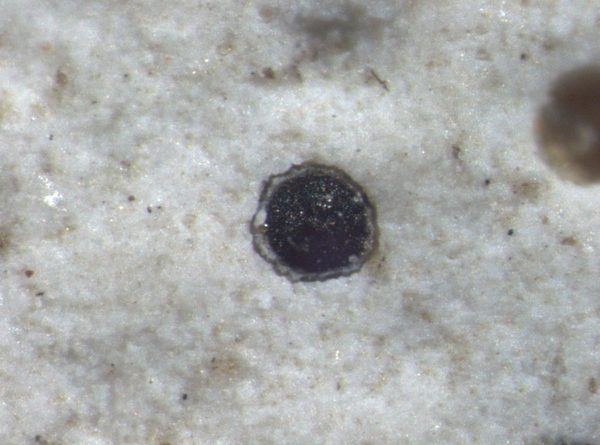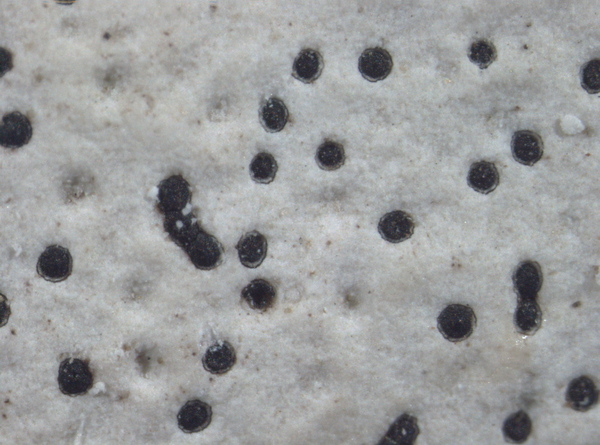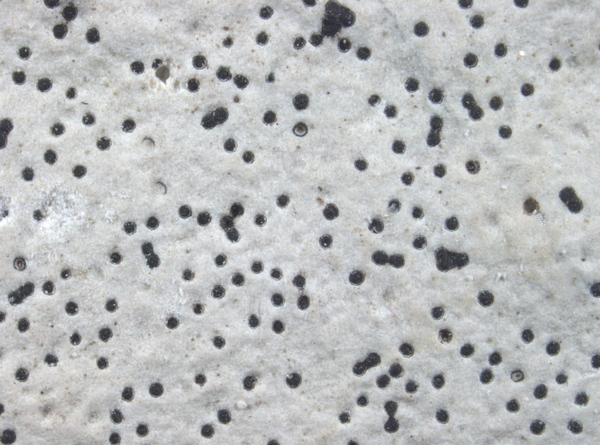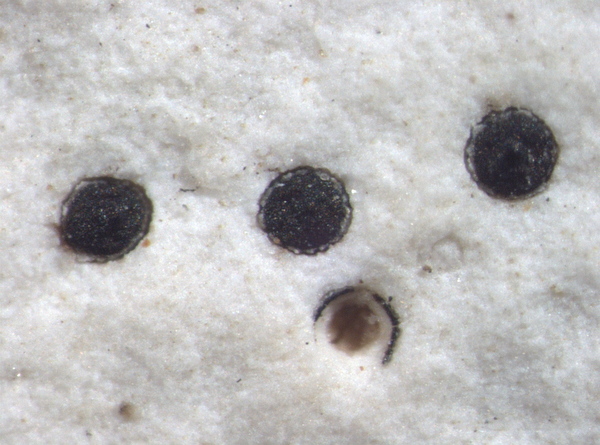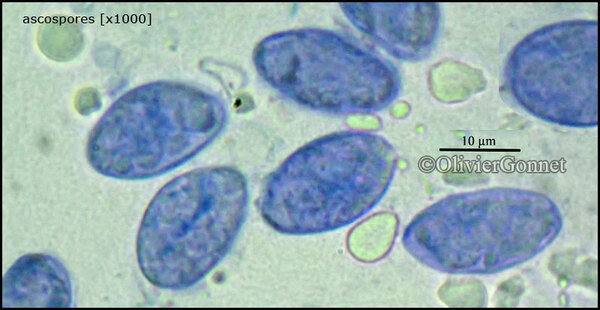Bagliettoa steineri (Kušan) Vězda
in Poelt & Vezda, Bibl. Lichenol., 16: 363, 1981. Basionym: Verrucaria steineri Kušan - Acta Bot. Inst. Univ. Zagreb, 5: 28, 1930.
Synonyms: Protobagliettoa steineri (Kušan) Servít ex J. Nowak & Tobol.
Distribution: N - VG (Tretiach & Navarro-Rosinés 1996, Geletti 1997, Tretiach & Pecchiari 1995), Frl (Breuss 2008), Lomb, Lig (Giordani & al. 2016). C - Umb (Genovesi & Ravera 2001, Ravera & al. 2006). S - Si (Caniglia & Grillo 2005, 2006).
Description: Thallus crustose, fully endosubstratic, usually covering large surfaces, white to pale grey, often delimited from adjacent thalli by a dark prothalline line. Cortex (lithocortex) densely prosoplectenchymatous, of conglutinated hyphae intermingled with microcrystals; algal layer discontinuous, the algal cells in clusters; medulla prosoplectenchymatous, sometimes with oil cells (macrosphaeroids) in lower part. Perithecia black, numerous, completely immersed in thallus and leaving deep pits in the rocks when they fall off. Involucrellum black, 0.15-0.33 mm wide, disc-shaped, with radial cracks around the ostiole, c. as large as or slightly larger than exciple; exciple colourless throughout, becoming pale brown only in old perithecia; hymenial gel hemiamyloid, I+ red (I+ blue at very low concentrations of I), K/I+ blue; hamathecium of periphyses in the ostiolar canal, and short periphysoids in the half upper part of the perithecial cavity; paraphyses dissolving early. Asci 8-spored, two-layered, fissitunicate, with a thin tholus reacting I-, Verrucaria-type. Ascospores 1-celled, hyaline, ellipsoid, often poorly developed, 13-26 x 8-15 µm. Photobiont chlorococcoid. Spot tests: K-, C-, KC-, P-, UV-. Chemistry: without lichen substances.
Note: a rarely collected, but probably much more common, mild-temperate species found on compact calcareous rocks, especially limestone, in natural habitats; frequently confused with B. baldensis, it should be looked for further throughout the country.
Growth form: Crustose endolithic
Substrata: rocks
Photobiont: green algae other than Trentepohlia
Reproductive strategy: mainly sexual
Commonnes-rarity: (info)
Alpine belt: absent
Subalpine belt: very rare
Oromediterranean belt: absent
Montane belt: rare
Submediterranean belt: rather rare
Padanian area: absent
Humid submediterranean belt: rather rare
Humid mediterranean belt: rare
Dry mediterranean belt: absent

Predictive model
Herbarium samples

Courtesy Danièle et Olivier Gonnet - Source: https://www.afl-lichenologie.fr/Photos_AFL/Photos_AFL_B/Textes_B2/Bagliettoa_steineri.htm
France, session AFL 2015 dans le Lot

Zschacke, H. (1934) Epigloeaceae, Verrucariaceae und Dermatocarpaceae. In: Dr. L. Rabenhorst‘s Kryptogamen-Flora, Band 9, Abt. 1, Teil 1. Akademische Verlagsgesellschaft, Leipzig, 695 pp. - Public Domain
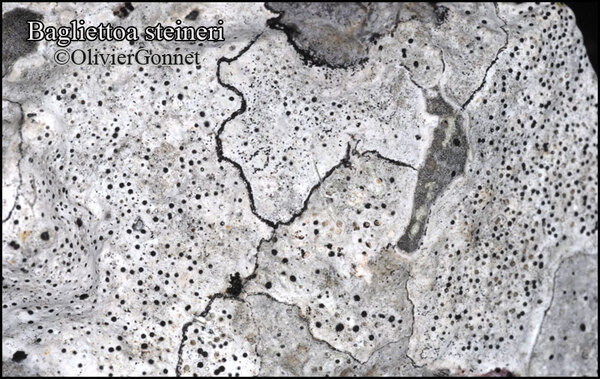
Courtesy Danièle et Olivier Gonnet - Source: https://www.afl-lichenologie.fr/Photos_AFL/Photos_AFL_B/Textes_B2/Bagliettoa_steineri.htm
France, session AFL 2015 dans le Lot

Courtesy Danièle et Olivier Gonnet - Source: https://www.afl-lichenologie.fr/Photos_AFL/Photos_AFL_B/Textes_B2/Bagliettoa_steineri.htm
France, session AFL 2015 dans le Lot
Growth form: Crustose endolithic
Substrata: rocks
Photobiont: green algae other than Trentepohlia
Reproductive strategy: mainly sexual
Commonnes-rarity: (info)
Alpine belt: absent
Subalpine belt: very rare
Oromediterranean belt: absent
Montane belt: rare
Submediterranean belt: rather rare
Padanian area: absent
Humid submediterranean belt: rather rare
Humid mediterranean belt: rare
Dry mediterranean belt: absent

Predictive model
| Herbarium samples |

Courtesy Danièle et Olivier Gonnet - Source: https://www.afl-lichenologie.fr/Photos_AFL/Photos_AFL_B/Textes_B2/Bagliettoa_steineri.htm
France, session AFL 2015 dans le Lot

Zschacke, H. (1934) Epigloeaceae, Verrucariaceae und Dermatocarpaceae. In: Dr. L. Rabenhorst‘s Kryptogamen-Flora, Band 9, Abt. 1, Teil 1. Akademische Verlagsgesellschaft, Leipzig, 695 pp. - Public Domain

Courtesy Danièle et Olivier Gonnet - Source: https://www.afl-lichenologie.fr/Photos_AFL/Photos_AFL_B/Textes_B2/Bagliettoa_steineri.htm
France, session AFL 2015 dans le Lot

 INDEX FUNGORUM
INDEX FUNGORUM
 GBIF
GBIF
 DOLICHENS
DOLICHENS
